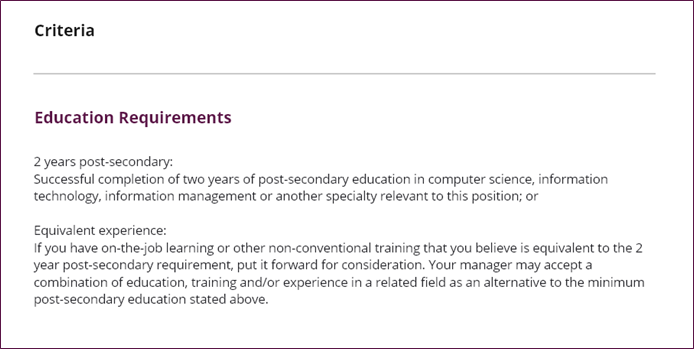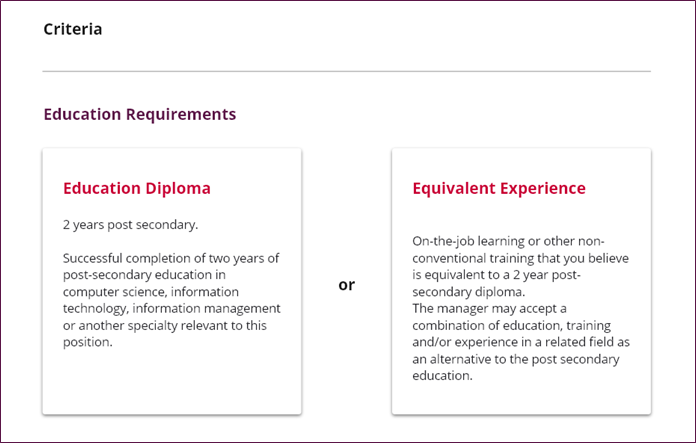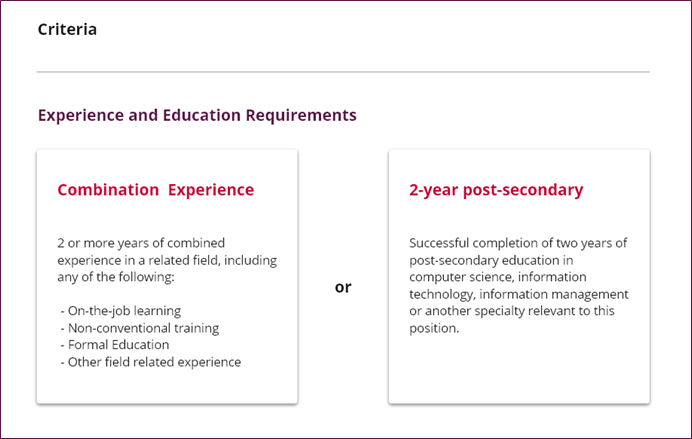Talent Cloud talks a lot about how much attention goes into the representation of literally every form field, process step and interaction on the platform for each of its user groups. To give you a better sense of how much effort and expertise it takes to get even a single form field or intervention working so it produces the intended hiring result (remember: focus on delivery!) we wanted to walk you through the development of a single feature of our platform: the essential education requirement in a job advertisement.
Talent Cloud set-out to develop a platform designed to attract, protect, and empower Indigenous talent to thrive within the Federal Government. And to achieve this goal we continuously design and test iteratively using user research.
In user research, critical failures occur when a user is unable to achieve their goal. At Talent Cloud, every qualified applicant should have a shot at a job they’re interested in, and that starts with submitting an application. Qualitative user research helps uncover the hidden paths that prevent applicants from applying.
Some of the earliest research on Talent Cloud focused on the current job poster’s design, layout, and the information it contained. But when we aim to attract a very specific subset of the population, we need to design in conjunction with that group, to address specific problems and design specific solutions. We reached out to the Indigenous Community to better understand their perspective as external job seekers, with the hopes of uncovering critical failures in our design.
A common myth in Government Hiring is that certain job classifications require a certain type and level of education degree. While that is true for a number of positions, it is more often than not an overgeneralization. The truth is that Hiring Managers can choose to accept any number of qualifications and forgo an Educational Requirement for many government classifications, as long as an applicant's qualifications add up to an Equivalent Experience.
For this purpose, we include a description of Equivalent Experience in every job poster whose classification allows it. This opens up the opportunity to a much larger pool of talent. And increase manager’s opportunities of finding a candidate with the right fit for their team.
“Education is a concept of everything that a person has learned throughout their life journey, which includes the lessons learned from lived experience.”
~ Talent Cloud’s Indigenous Community Liaison
When testing our job poster designs with members of the Indigenous community we asked: “Would you apply for this job? And Why?” Many responded “No” despite being qualified for the job advertisement. Critical Failure.
While the text on the Education Requirement section provided information regarding Equivalent Experience, the language and layout used to display the information on the job poster included unconscious-bias.

The language and design in our titles catered information to applicants who already meet the criteria, and hid important information in the second paragraph for users looking for an alternative path. Applicants would only read the title or the first sentence, and immediately filter themselves out despite meeting the criteria in the second paragraph. We tested a different version: a side-by-side version to improve visibility of the Equivalent Experience but the problem persisted.

Design principles state that information is generally consumed Top-to-bottom and Left-to-right. And in addition users “skim” information instead of reading it. Our first skimmed elements are: Education Requirements -> Education Degree or Diploma -> Equivalent Experience -> 2 years post-secondary. As such, this design strongly prioritizes Western education, diplomas, and degrees, as the most important requirement to apply for the position. We learned that even when applicants read the Equivalent Experience section they wondered if a “hidden hierarchy” existed behind the scenes, and whether they would have enough to compete with applicants who had a degree.
Placing the two concepts side-by-side (rather than above/below), was a deliberate choice. The attempt was to reflect the absence of a hierarchy between the two options. But by placing Education Degree Requirement first and calling the alternative option Equivalent Experience we are still showing a preference for the former and framing the latter as a dependent lesser version. This layout change was not enough to solve the problem.
However, if the Degree Requirement and Equivalent Experience are truly equal, it means we can reorder them, and define the language in a way that the distinction is clear and showing their independent value. In the hopes of removing bias for “diploma” based applications.
In our last design we present alternative information first to those who are looking for it, and give validation second to those who already meet traditional requirements. This design caters information to those who need reassurance and guidance the most, promoting job opportunities for everyone, not only those with access to traditional western education.

Diversity creates higher quality products. As designers of products and services we must remember the dangers of implicit bias; It is invisible by nature and it hinders representation. But if we make an effort to include the voices missing from our teams, we can help mitigate some of these errors. And we can finally begin to remove barriers and do our part to advance reconciliation.
All jobs require the ability to demonstrate certain skills - there is no debate about that. But the way the requirements are framed has a huge bearing on inclusion and diversity outcomes, particularly when unconscious cultural preferencing is going unchecked.
The emphasis on rethinking the representation for education requirements for Indigenous applicants isn’t because Indigenous talent doesn’t have that education. It’s because we can’t, (underline absolutely can not) ignore the impact of Canada’s residential schools on Indigenous talent and assume a general willingness on behalf of the Indigenous community to accept the primacy of the Western education system in the job application process. For GC hiring processes to engage this way with Indigenous talent risks perpetuating ignorance, indifference and racism.
It’s important to note that while the work on how education requirements are presented was originally designed with Indigenous talent on the prototype of the Indigenous talent portal, the representation of these requirements is now a feature on our main platform. This is part of the team’s commitment to change the default that all applicants experience. Too often, “special features” are created in separate recruitment tools or processes for those in non-mainstream communities, while the default on the main platform goes unchanged. And that’s the crux of it.
All Government systems were built by people… and people grow up in communities and come with histories, cultures, and values. It can be hard to spot the underlying culture-based assumptions built into systems design, especially when the group that designed the system is the same group attempting to identify assumptions in the system. But these assumptions can have a big impact on the experiential equality of inclusion. The first step towards inclusive design is the acknowledgement that everything in a system was built by people, and because of this, people can change it. Making the change means engaging people from communities that were underrepresented when the original system was created, and giving power to new voices in the redesign process.